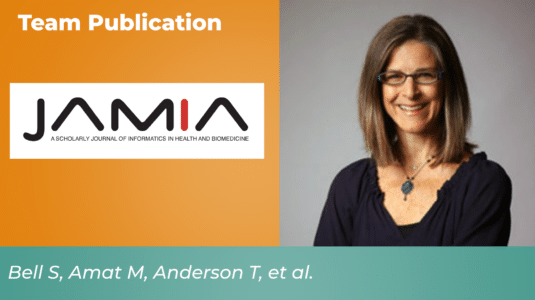Compared to no portal registration, the odds of loop closure were 20% higher in tests/referrals for patients with a portal account, and 40% higher in tests/referrals for note readers, after controlling for sociodemographic and clinical factors. However, important safety gaps from unclosed loops remain, requiring additional engagement strategies.
Fernandez, Leonor
Words Matter: What Do Patients Find Judgmental or Offensive in Outpatient Notes?
One in 10 respondents reported feeling judged/offended by something they read in an outpatient note due to the perception that it contained errors, surprises, labeling, or evidence of disrespect. The content and tone may be particularly important to patients in poor health. Enhanced clinician awareness of the patient perspective may promote an improved medical lexicon, reduce the transmission of bias to other clinicians, and reinforce healing relationships.
Patients Evaluate Visit Notes Written by Their Clinicians: a Mixed Methods Investigation
Patients overwhelmingly report understanding their visit notes and usually find them accurate, with few disparities according to sociodemographic or health characteristics. They have many suggestions for improving their quality, and if they understand a note poorly or find inaccuracies, they often have less confidence in their clinicians.
The Views and Experiences of Clinicians Sharing Medical Record Notes With Patients
In this web-based survey study of 1628 clinicians, most viewed note sharing positively (74% agreed that it is a good idea and 74% viewed shared notes as useful for engaging patients in their care), and 37% of physicians surveyed reported spending more time in documentation. Physicians with more years in practice and fewer hours spent in patient care had more positive opinions overall.
Empowering patients and reducing inequities: is there potential in sharing clinical notes?
Patients who read their clinical notes via online patient portals (‘open notes’) report that doing so engages them actively in their care, improves their sense of control over their health and enhances safety. In several surveys, patients who are older, less educated, non-white or whose first language is not English report even greater benefits than do their counterparts. However, for many reasons, persons from these demographic groups are less likely to use health portals than other patient populations.
Patients Managing Medications and Reading Their Visit Notes: A Survey of OpenNotes Participants
We examined patients’ perceptions of how note reading affects factors related to medication adherence. In addition, we sought to understand their engagement with online medication lists and their willingness to participate in keeping those lists correct and up to date.
OpenNotes After 7 Years: Patient Experiences With Ongoing Access to Their Clinicians’ Outpatient Visit Notes
Following a 2010-2011 pilot intervention in which a limited sample of primary care doctors offered their patients secure Web-based portal access to their office visit notes, the participating sites expanded OpenNotes to nearly all clinicians in primary care, medical, and surgical specialty practices.
The Importance of Visit Notes on Patient Portals for Engaging Less Educated or Nonwhite Patients: Survey Study
Less educated and nonwhite patients using the portal each assigned higher importance to reading notes for several health behaviors than highly educated and white patients, and may find transparent notes especially valuable for understanding their health and engaging in their care. Facilitating access to notes may improve engagement in health care for some vulnerable populations who have historically been more challenging to reach.
Sharing visit notes: Getting patients and physicians on the same page
Shared notes enhance communication and engagement among patients, clinicians, and family members and can be an important facilitator of shared decision making. Patients report valuable clinical benefits, including improved adherence to their medications and treatment plans. Patients want transparency, and those who have experienced shared notes believe the practice should continue. Most providers who share notes want to continue the practice as well and do not report an increase in time spent writing notes.
The essence of morning
Hot coffee beckons with its promise of contraband comfort on a cold and busy Monday morning. Ms. H, my first patient, has not arrived yet. I consider a quick dash downstairs to the coffee shop. I can usually make it back in 4 minutes.… I glance at my email. You have 2 new PatientSite messages. I stay.
I close the many open windows on my computer and open the link. I approach the blinking vigil of the messages as I might a covered wound—with a mix of curiosity, a desire to help, and a sense of impending doom. I feel two competing desires: to leave the bandage on or lift it off as quickly as possible. A subconscious triage occurs—do I have enough time, attention, and emotional energy to respond in this moment?
The first email is from Diana and it dispels the fog of distracted multitasking. I hear her voice as I read: “Doctora, ¿Como esta? Y la familia…?” She continues, in Spanish: “Thanks for seeing me on Friday. I read your office note. The fever is gone and I am feeling better. Can you schedule the PET scan sooner? Also, when you have a momentico, can you give me a call? I want to ask you about some of the blood tests. Affectionately, Diana.”




